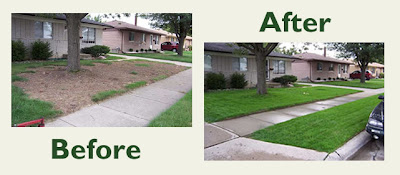Mow at the highest setting on your lawn mower until the grass enters dormancy. See How High to Mow Your Yard for the Final Cut. Once dormant, the grass no longer needs as much above ground growth. For the final mowing of the season, lower the cutting height to about two inches for cool-season grasses and one inch for warm-season grasses. Left too long, the grass will lay over and trap moisture beneath. This makes conditions favorable for diseases to develop next season.
Regularly remove leaves (especially wet ones) to keep them from smothering the grass. After the bulk of fallen leaves have been disposed of , use a mulching mower for the last few scattered leaves. The shredded leaves will slowly decompose and add organic matter to the soil, just like in a compost. See "Do the tree leaves that fall help your lawn?" By following the good fall lawn care practices outlined here, your lawn should be well prepared for winter and reward you with a quick green-up come spring.
Aeration
Fall is also the best time to seed bare patches, or to start a new lawn, unless you are planting warm-season grasses, which are best sown in late spring or early summer. This is also the season to perform two other important lawn care tasks --aeration and overseeding. Aeration is done by a machine called an aerator, heavy machinery that pulls plugs of soil from the lawn. The result is a pattern of holes that permit freer movement of air, nutrients, beneficial microorganisms, and water, and also gives more room for the roots to grow. You can rent an aerator, but for the money and time you’d spend, you'd be better off to have it done professionally. After aerating your lawn is the best time to overseed with a grass blend suited to your region's climate and amount of sun exposure in your yard.
Overseeding
Because of very hot temperatures this past summer, overseeding may be necessary. See Fall Overseeding. Overseeding is broadcasting seed into an established lawn to rejuvenate it. Use a cool-season turf grass variety that will enable you to enjoy an attractive lawn well into the fall and early winter months. September is the month for most climates to begin preparing your lawn for fall and winter weather, but it's not too late. Start by closely inspecting your lawn for weeds. Spray them with an herbicide to eliminate weed competition. Wait until the label on the herbicide says it's okay to start over-seeding, then cut the grass as low as possible. Also aerate or dethatch the lawn before over-seeding. One such product is Southern States' Premium Turf Type Tall Fescue.™ Fall is also an ideal time to establish a new lawn. Use a premium lawn starter with phosphorus for increased root development of seedlings and high potassium. This will aid in disease resistance and cold hardiness. After planting, use a good all-season fertilizer. to improve winter hardiness, as well as to promote early spring green-up.
Fertilizing
 |
| http://multivu.prnewswire.com/mnr/trugreen/45815/ |





